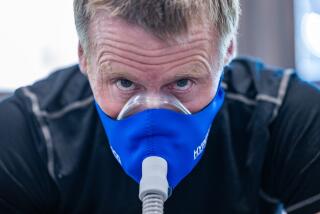Higher summits for today’s backpacking gear
- Share via
OK, California didn’t get any snow again. Water rationing is now mandatory. Spring is the new summer. But look on the bright side: It’s a great time to go backpacking. On top of that, the basic gear you need, the big four — boots, tents, poles and backpacks — just keep getting better. Just remember to stay hydrated.
Bootstrap success
Bogs Tumalo: The economical, waterproof, mid-ankle leather hiking boot has built-in pull-up handles.
Likes: The boots go on effortlessly and can be worn painlessly. No more wrestling match, as the built-in handles (a Bogs signature, which I’ve not seen on other boots) made putting these on a breeze. Why hadn’t anyone else thought of this? The wide toe box, more rounded than many others, made them very comfy for my D-width feet throughout my initial four-hour hike/snowshoe trek. They had good ankle support, a sweat-evaporating lining, easy-lace eyelets and a burly but bouncy outer sole.
Dislikes: None.
Price: $130. bogsfootwear.com
Poles apart
Leki Micro TourStick Vario trekking poles: This three-part, adjustable-length folding pole has a carbon section on top and aluminum lowers. Connected with a press-fit and tent-pole-style tension-cords, they break down to 15.5 inches long and weigh 18 ounces per pair.
Likes: Hiking poles make life way easier on the trail, no matter your pack’s weight, because they allow you to transfer some of the load from legs to arms. I also love them for the all-body rhythm and balance they give. These high-end poles are designed to last, with stainless steel connectors, aluminum sleeves protecting the carbon tubes and Kevlar-reinforced tension cords. They have a rock-solid feel and 20 centimeters of length adjustment via a quick-release Speed Lock on the top section. A nylon stuff sack is included. Note: Similar features and dimensions can be found on Leki’s low-end, all-aluminum Micro Vario PAS; 19.9 ounces per pair, $119.
Dislikes: None.
Price: $199.95. leki.com
Body-hugging pack
Osprey Atmos 50 AG EX Pack: The 50-liter, heavy-duty nylon backpack with load capacity of 25 to 40 pounds features seamless body-hugging mesh webbing from neck to hip. This supposedly reduces fatigue and gives the perception of a lighter load.
Likes: Very comfortable and efficient during long treks. That’s due to two things: the well-ventilated yet close-to-the-body design and the instant access to food and water from the hip pockets and the hydration-compatible internal hydration sleeve. (Packs that lack these are a hassle because you have to stop to dig nutrition out of your pack; that prompts many to skip it to keep moving.) Other nice features include side compression straps to minimize and stabilize the load; a zippered sleeping bag compartment in the bottom; a removable floating lid with two pockets for valuables, including rain cover and dry sack (included); external loops and attachments for tools and poles; and numerous stretch pockets for extra water, maps and gear. It weighs 4 pounds in a medium size.
Dislikes: Hydration bladder not included.
Price: $229. ospreypacks.com
Room with a view
Mountain Hardwear Optic 2.5 tent: This extra-big, two-person tent is designed with large, mesh, zippered doors adjoining at a corner (instead of on parallel sides, as is the convention). When opened together, they provide a living-room-window view.
Likes: Comfy. A big footprint of 37 square feet handles 6-footers well and has plenty of room inside for your packs. It includes two vestibules and internal pockets along the corner for cellphones, lights and personal items, so it’s easy to keep the interior clean, dry and organized. With a carabiner clip that connects the two main poles, it sets up very quickly.
Dislikes: Although it packs up small, it’s rather heavy for long backpacking trips at 6.2 pounds. And there are much less expensive two-person tents (but without the view).
Price: $240. mountainhardwear.com
Wallack is the author of “Bike for Life: How to Ride to 100 — and Beyond.”






